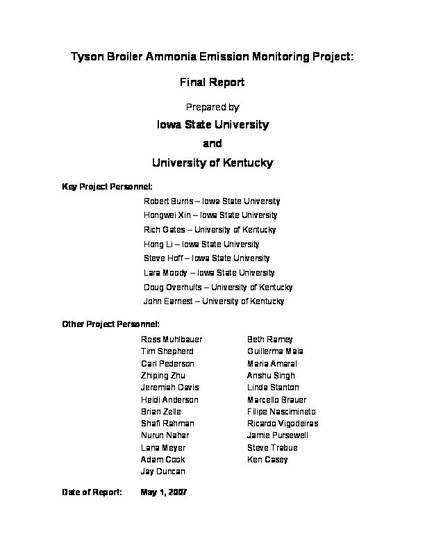
This report describes the measurement methodologies and results of ammonia (NH3) emissions from two typical Tyson broiler production houses located in western Kentucky. During this study, comprised over 13 months and with six flocks per house, a total of 12 flocks of high quality emissions data were collected. Continuous measurement over a one-year period allowed for delineation of variations in emissions due to seasonal effects, animal growth cycles, and litter conditions. The study was led by Iowa State University (ISU), in collaboration with the University of Kentucky (UK). Data from this study add to and improve the national inventory on ammonia emissions from animal feeding operations (AFOs), especially broiler houses in the southeastern United States.
The two broiler houses monitored in this study are designated as Tyson 1-5 or T1-5 and Tyson 3-3 or T3-3 in this report. The monitoring periods reported are 10/07/05 – 11/27/06 for T3-3 and 12/09/05 – 1/09/07 for T1-5. Note that ammonia monitoring began on 10/01/05 in both houses, but no birds were placed in T1-5 until 12/09/05, explaining the different emissions reporting periods. The ammonia emissions reported in this study are based on continuous measurements of ammonia concentration in the inlet and exhaust air and the corresponding mechanical ventilation rate at each broiler house. Two Mobile Air Emissions Monitoring Units (MAEMUs), housing state-of-the-art measurement equipment, calibration accessories, and data acquisition systems, were developed at Iowa State University and used for this monitoring project.
Prior to the initiation of monitoring, a series of performance tests were conducted to confirm that the monitoring systems were working as designed and to determine representative locations for air sampling points. An EPA Category 1 Quality Assurance Project Plan (QAPP) – a substantial, 400-page document that outlines the methodologies for the project – was developed by the monitoring team. This Category 1 QAPP was reviewed and approved by EPA. In addition, the project underwent and passed two technical audits: a technical audit by Battelle personnel (contractors hired by EPA) confirming conformance of the project implementation with our QAPP, and an additional technical audit conducted by two nationally prominent agriculture air quality scientists.
Available at: http://works.bepress.com/steven_hoff/130/

The magnitude of ammonia emissions in this study is expressed as annual total on the basis of per bird, per animal unit (AU, = 500 kg or 1100 lb live body weight) or per 1,000 birds marketed, daily mean, daily maximum, flock total, during downtime (i.e., between flocks), and, with a 10% or less uncertainty. These respective values are: a) annual (365-d) emission (including downtime emissions) of 5.1 US tons per house or 77.9 lb/1,000 birds marketed (or 35.4 g/bird marketed); b) 12-flock daily mean (± standard deviation) emission of 30.8 ± 20.0 lb/d-house or 0.91 ± 1.29 lb/AU-d; c) maximum grow-out daily emission of 67.4 lb/d-house for T1-5 and 78.2 lb/d-house for T3-3; d) mean (± SD) flock total emission of 1545 ± 298 lb/flock; and e) mean (± SD) downtime emission of 19.3 ± 18.2 lb/d-house. Flocks on new litter had a lower emission rate of 27.2 ± 20.6 lb/d-house, as compared to 32.0 ± 19.6 lb/d-house for flocks on built-up litter. Ammonia emission tended to be higher during the warmer weather. Bird age is the predominant influencing factor on ammonia emissions. As such, an empirical equation has been established that relates ammonia emission to bird age for the monitored broiler houses. Compared with the US EPA ammonia emission factor of 100 g/yr-bird (100 g/bird marketed), the magnitude of emission reported from this study is 35.4% of the EPA cited value. The use of an emission factor is not advised for systems such as broiler facilities in which substantial progressive daily variation occurs as birds grow and then are removed repeatedly over a year. The use of emission per 1000 birds marketed more realistically captures the events and allows for emission inventory tracking.